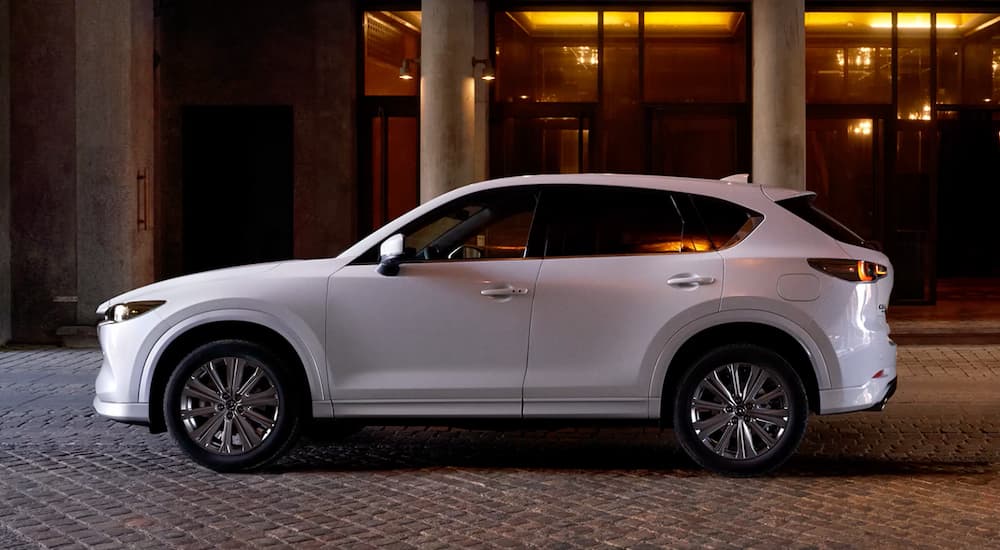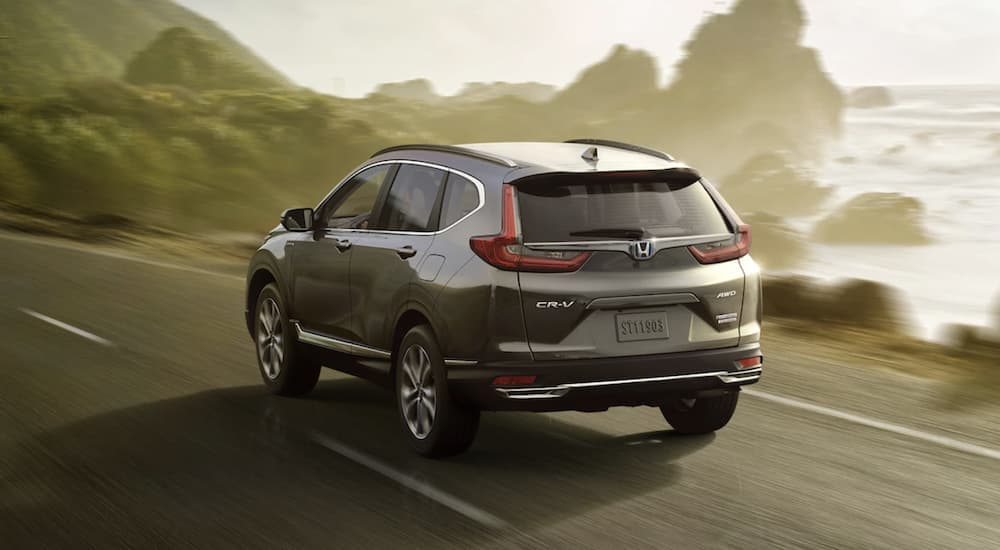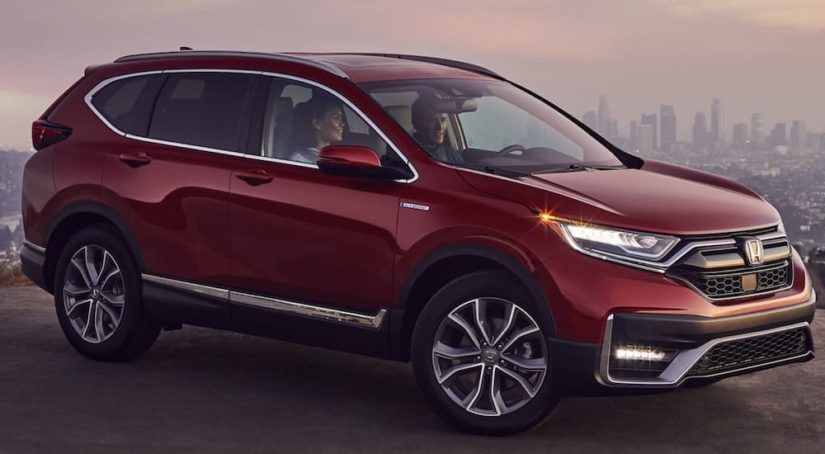If you’re shopping for a new compact SUV, you may be struggling with one decision: the 2022 Honda CR-V vs 2022 Mazda CX-5. Which one is the best for you? It’s a tough question! These are two of the best small SUVs on the market today. Both models have repeatedly won awards from Motor Trend and Car and Driver since their arrival, and both are on Car and Driver’s 2022 Editor’s Choice List. The current generations of the Honda CR-V and the Mazda CX-5 have both been with us since 2017, and they continue to be extremely popular vehicles. Both are available in enough variation––five trims and a hybrid for the CR-V, eight trims for the CX-5––to provide that Goldilocks choice for every shopper. So which 2022 model is right for you?
Let us help you remove some of the mystery from that question.
Choices, Choices…
First, consider your top priorities in a vehicle. Since you’re looking at compact SUVs, you probably want to move a few people around. Maybe some stuff. How much room do you need? There are other questions to consider. How important is your driving experience to you? Safety? Reliability? Cost? Identifying what’s most important to you, as well as what you plan to spend, can help you narrow your choice. Given the high reliability ratings for both models, it’s worth your time to carefully consider your needs. Depending, of course, on your vehicle replacement habits, you could expect to be driving either of these cars for some years to come.
What’s New in ’22?
First, let’s look at what changed in this model year. It’s an easy answer for the CR-V––nothing. Since a case can be made that this Honda easily stands on its current merits, that’s not surprising. Mazda has, however, introduced a few changes for the 2022 CX-5. Probably the most notable among these is making AWD standard across the lineup, including the base 2.5 L. The 2022 CX-5 also adds a standard 10.5 in infotainment screen, comfier seats, and some redesign in the body, reaching for a sleeker, sportier appearance (particularly in the Turbo trims). Some small frame and suspension improvements also result in greater overall ride comfort.

AWD or FWD?
For the non-gearheads among us, this is worth a little digression––what’s the difference between front-wheel drive (FWD), still standard on the CR-V and many other cars, and all-wheel drive (AWD)? Ultimately, it’s simple. FWD delivers power only to the front wheels, AWD to all four, though how that’s done can vary. There are advantages and disadvantages to each. FWD offers less overall traction since one wheel slipping leaves only one other to grab the road.
However, since there’s less machinery taking up space, FWD vehicles tend to have more legroom, and that additional AWD machinery can mean more parts to break, raising repair costs. AWD can also mean more tire replacement, as all four tires receive more wear. Mazda has, however, provided a solution for that problem and another often-noted disadvantage to AWD––poorer fuel efficiency. The CX-5’s “intelligent” i-ACTIV AWD is only applied when road conditions make it an advantage, such as when overall traction is reduced, thus keeping fuel use within reason (26 MPG combined) and reducing unnecessary tire wear.
How Much Do You Want To Haul?
Since this is an area of some interest to most SUV buyers, let’s look at it. Both the Mazda CX-5 and the Honda CR-V can carry five passengers. Storage space varies with seats-up or seats-down configurations, and the CX-5 has somewhat less at 59.3 cubic ft with seats down (though it gets points for the fact that its folded seats can be dropped separately and actually lie flat.) The CR-V manages to offer an incredible 75.8 cubic ft of storage with the seats down, even in its AWD-standard Touring trim. The CX-5 enables a slightly greater towing capacity of 2,000 lbs to the CR-V’s 1,500 lbs, but it is somewhat academic as neither of these vehicles is well-suited to towing.
Turbo or Hybrid?
While these elements aren’t precisely comparable, they certainly express a difference and one that may help you make up your mind between the two options. Honda continues to offer the CR-V in a well-rated hybrid model available in three different trims. The 2.0L, 212 hp engine offers 38 MPG combined at an MSRP of $31,610, with a still-reasonable seats-down cargo space of 68.7 cubic feet. Unsurprisingly, Honda doesn’t recommend that you try to tow anything with it!
The Mazda CX-5 isn’t available in a hybrid form. Instead, it offers a high-horsepower turbocharged engine. The renamed, somewhat restyled 2.5 Turbo Signature––the top of the line model––logs in at an MSRP of $38,650. For the same 2.5L, 227-256 hp engine (the difference depends on whether you use standard or premium gas), you can pick up the 2.5 Turbo trim for $36,400. The Signature features additions such as a 360° view monitor, Nappa leather seats, and layered genuine wood trim. Both the 2.5 Turbo and the 2.5 Turbo Signature contain the Mazda Intelligent Drive Select (Mi-Drive) System in their Sport and Off-Road modes, which allows the driver to configure AWD function. (The standard CX-5 i-ACTIV AWD is automatically applied by the vehicle based on sensor data.)
The 2022 CR-V standard engine is also turbocharged, but the smaller 1.5L is designed for economy rather than power. The result is an engine that reviewers generally seemed to regard as workmanlike and efficient, if not flashy. It does maintain good fuel efficiency, typically a bit better than the base engine in the CX-5.

Safety and Driver-Assistive Technology
The CR-V and the CX-5 each scored a 5 on the NHTSA Safety Rating Scale––something we’ve come to expect from Mazda and Honda. Each company has racked up an impressive series of safety ratings, and the CR-V and CX-5 don’t disappoint.
Both vehicles contain comparable driver assists as well, the CR-V through the Honda Sensing suite and the CX-5 through Mazda’s i-Activsense Safety technology. Though these technologies go by different names and have slightly different features, both cars are equipped with adaptive cruise control (which monitors your following distance and adjusts speed automatically), lane departure warning and mitigation to help you stay in your lane, forward collision warning and mitigation with pedestrian detection, alerting the driver to potential collisions and braking to help avoid them
So…Which Will You Choose?
Mazda has made an effort to upgrade luxury and sport-related features in the 2022 CX-5. Reviewers generally note an improvement in materials and comfort, with several commenting that the turbo trims, in particular, provide a much more luxurious, elegant feel. Opinions vary on whether the shift to standard AWD was a necessary improvement, but the CX-5 seems to be, like Jack of the candlestick, undeniably nimble and quick for its class.
The infotainment system in the CX-5 comes equipped with Apple CarPlay and Android Auto in all trims. However, you’ve got to move up to the 2.5 S Premium (at the MSRP of $32,310) to get the ten-speaker Bose stereo system; the standard 2.5 S only has four speakers.
The 2022 Honda CR-V, while not garnering the same excited cheers for its performance qualities, certainly has its own strengths in terms of familiarity, sturdiness, known reliability, fuel efficiency, and more cargo space. Apple CarPlay and Android Auto are standard on the Special Edition trim on up but not on the base LX, which has four speakers, graduating to 8 on the EX-L (at the MSRP of $31,500.)
Overall, both of these cars are reasonably-priced SUVs designed for moving people and stuff on typical roads at normal speeds. Both are safe, comfortable, and capable. But which will you choose? The 2022 Honda CR-V or the 2022 Mazda CX-5? We hope this discussion of what each has to offer makes your decision a little easier!



